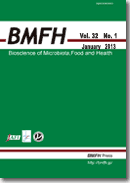Excess accumulation of white adipose tissue can lead to obesity-related metabolic abnormalities such as insulin resistance. We previously reported that intragastric administration of
Lactobacillus plantarum No. 14 reduced adipocyte size in diet-induced obese C57BL/6 mice. The present study tested whether
L. plantarum No. 14 affects adiposity and insulin sensitivity in an animal model of type-2 diabetes mellitus. Male KK/Ta mice were fed a normal-fat diet and intragastrically given
L. plantarum No. 14 (10
8 CFU/mouse) or vehicle daily for 10 weeks. Interscapular brown adipose tissue and inguinal, mesenteric, and retroperitoneal white adipose tissue weights, serum leptin and insulin concentrations, and insulin resistance index (HOMA-IR) were significantly lower in
L. plantarum No. 14-fed mice than in vehicle-fed mice. The sum of the inguinal, epididymal, mesenteric and retroperitoneal white adipose tissue weights correlated with serum leptin and non-esterified fatty acid concentrations and HOMA-IR. The mesenteric adipose tissue mRNA levels of monocyte chemoattractant protein-1 and tumor necrosis factor-α were significantly lower in
L. plantarum No. 14-fed mice than in vehicle-fed mice. Mesenteric adipose tissue weight correlated with interleukin-6, monocyte chemoattractant protein-1, and tumor necrosis factor-α mRNA levels. HOMA-IR correlated with monocyte chemoattractant protein-1 and tumor necrosis factor-α mRNA levels. These data suggest that
L. plantarum No. 14 prevents the development of insulin resistance, which is at least partly attributable to the prevention of obesity, in KK/Ta mice.
View full abstract
